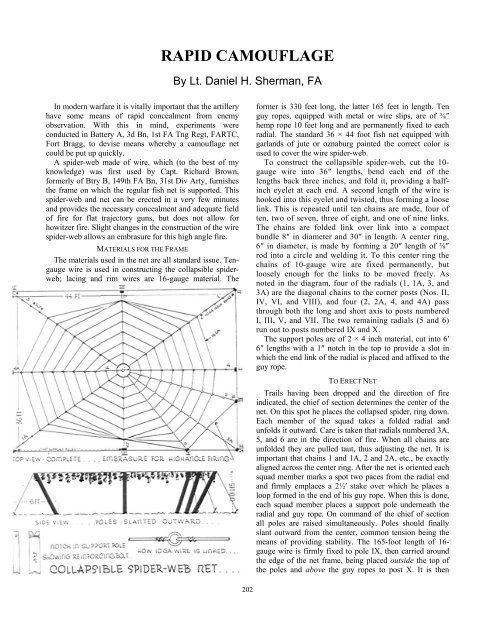the field artillery journal - Fort Sill - U.S. Army
the field artillery journal - Fort Sill - U.S. Army
the field artillery journal - Fort Sill - U.S. Army
Create successful ePaper yourself
Turn your PDF publications into a flip-book with our unique Google optimized e-Paper software.
In modern warfare it is vitally important that <strong>the</strong> <strong>artillery</strong><br />
have some means of rapid concealment from enemy<br />
observation. With this in mind, experiments were<br />
conducted in Battery A, 3d Bn, 1st FA Tng Regt, FARTC,<br />
<strong>Fort</strong> Bragg, to devise means whereby a camouflage net<br />
could be put up quickly.<br />
A spider-web made of wire, which (to <strong>the</strong> best of my<br />
knowledge) was first used by Capt. Richard Brown,<br />
formerly of Btry B, 149th FA Bn, 31st Div Arty, furnishes<br />
<strong>the</strong> frame on which <strong>the</strong> regular fish net is supported. This<br />
spider-web and net can be erected in a very few minutes<br />
and provides <strong>the</strong> necessary concealment and adequate <strong>field</strong><br />
of fire for flat trajectory guns, but does not allow for<br />
howitzer fire. Slight changes in <strong>the</strong> construction of <strong>the</strong> wire<br />
spider-web allows an embrasure for this high angle fire.<br />
MATERIALS FOR THE FRAME<br />
The materials used in <strong>the</strong> net are all standard issue. Tengauge<br />
wire is used in constructing <strong>the</strong> collapsible spiderweb;<br />
lacing and rim wires are 16-gauge material. The<br />
RAPID CAMOUFLAGE<br />
By Lt. Daniel H. Sherman, FA<br />
202<br />
former is 330 feet long, <strong>the</strong> latter 165 feet in length. Ten<br />
guy ropes, equipped with metal or wire slips, are of ⅜″<br />
hemp rope 10 feet long and are permanently fixed to each<br />
radial. The standard 36 × 44 foot fish net equipped with<br />
garlands of jute or oznaburg painted <strong>the</strong> correct color is<br />
used to cover <strong>the</strong> wire spider-web.<br />
To construct <strong>the</strong> collapsible spider-web, cut <strong>the</strong> 10gauge<br />
wire into 36″ lengths, bend each end of <strong>the</strong><br />
lengths back three inches, and fold it, providing a halfinch<br />
eyelet at each end. A second length of <strong>the</strong> wire is<br />
hooked into this eyelet and twisted, thus forming a loose<br />
link. This is repeated until ten chains are made, four of<br />
ten, two of seven, three of eight, and one of nine links.<br />
The chains are folded link over link into a compact<br />
bundle 8″ in diameter and 30″ in length. A center ring,<br />
6″ in diameter, is made by forming a 20″ length of ⅜″<br />
rod into a circle and welding it. To this center ring <strong>the</strong><br />
chains of 10-gauge wire are fixed permanently, but<br />
loosely enough for <strong>the</strong> links to be moved freely. As<br />
noted in <strong>the</strong> diagram, four of <strong>the</strong> radials (1, 1A, 3, and<br />
3A) are <strong>the</strong> diagonal chains to <strong>the</strong> corner posts (Nos. II,<br />
IV, VI, and VIII), and four (2, 2A, 4, and 4A) pass<br />
through both <strong>the</strong> long and short axis to posts numbered<br />
I, III, V, and VII. The two remaining radials (5 and 6)<br />
run out to posts numbered IX and X.<br />
The support poles are of 2 × 4 inch material, cut into 6′<br />
6″ lengths with a 1″ notch in <strong>the</strong> top to provide a slot in<br />
which <strong>the</strong> end link of <strong>the</strong> radial is placed and affixed to <strong>the</strong><br />
guy rope.<br />
TO ERECT NET<br />
Trails having been dropped and <strong>the</strong> direction of fire<br />
indicated, <strong>the</strong> chief of section determines <strong>the</strong> center of <strong>the</strong><br />
net. On this spot he places <strong>the</strong> collapsed spider, ring down.<br />
Each member of <strong>the</strong> squad takes a folded radial and<br />
unfolds it outward. Care is taken that radials numbered 3A,<br />
5, and 6 are in <strong>the</strong> direction of fire. When all chains are<br />
unfolded <strong>the</strong>y are pulled taut, thus adjusting <strong>the</strong> net. It is<br />
important that chains 1 and 1A, 2 and 2A, etc., be exactly<br />
aligned across <strong>the</strong> center ring. After <strong>the</strong> net is oriented each<br />
squad member marks a spot two paces from <strong>the</strong> radial end<br />
and firmly emplaces a 2½′ stake over which he places a<br />
loop formed in <strong>the</strong> end of his guy rope. When this is done,<br />
each squad member places a support pole underneath <strong>the</strong><br />
radial and guy rope. On command of <strong>the</strong> chief of section<br />
all poles are raised simultaneously. Poles should finally<br />
slant outward from <strong>the</strong> center, common tension being <strong>the</strong><br />
means of providing stability. The 165-foot length of 16gauge<br />
wire is firmly fixed to pole IX, <strong>the</strong>n carried around<br />
<strong>the</strong> edge of <strong>the</strong> net frame, being placed outside <strong>the</strong> top of<br />
<strong>the</strong> poles and above <strong>the</strong> guy ropes to post X. It is <strong>the</strong>n

















